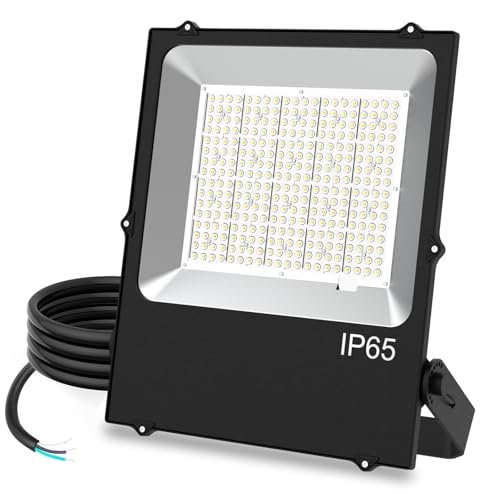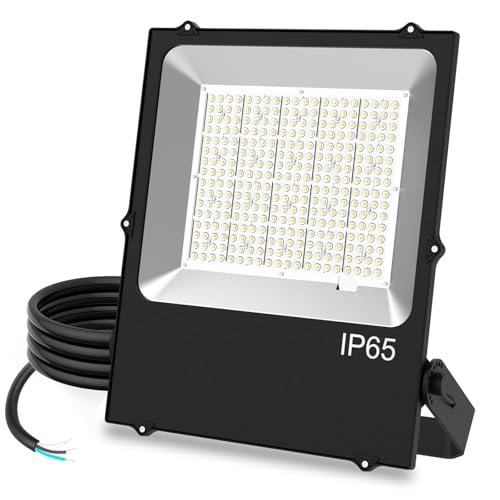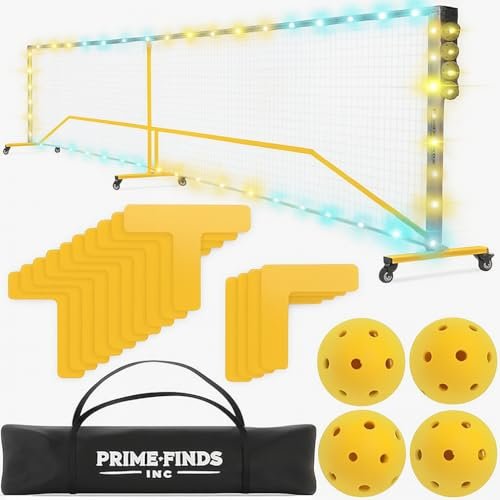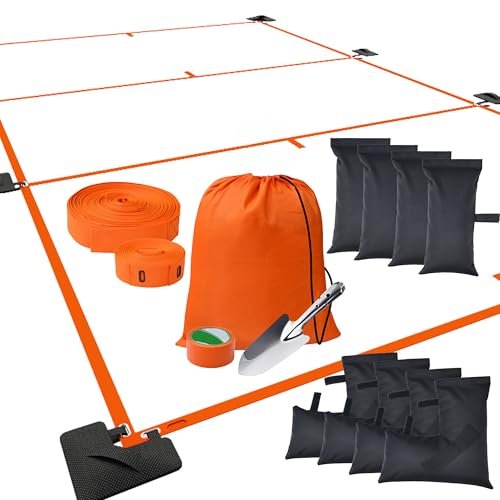You’re trying to find that perfect balance where the yellow ball doesn’t get lost against the glare or the shadows. When I first had to install lights for pickleball courts, I felt less like a player and more like an electrical engineer guessing lumens. Trust me, we can skip the guesswork.
As a dedicated player who spends as much time reviewing equipment as I do dinking, I’ve discovered that true night pickleball requires more than just a bright bulb. It demands specific light temperature, zero flicker, and, critically, proper coverage. I’ve spent countless hours on various court surfaces testing everything from massive stadium floodlights to simple glow-in-the-dark accessories. I’m here to guide you through the lights for pickleball courts that truly perform when the sun goes down.
In my comprehensive testing, I focused on products that offer solutions for every scenario—from dedicated permanent courts requiring professional floodlights to temporary setups where portable gear makes the difference.
Choierlight 300W Stadium Flood Lights 5000K Daylight
When I tested this Choierlight system, I immediately noticed how it combines multiple technical features into a high-powered, cohesive design aimed squarely at sports courts. I found the integration of the robust IP65 housing with the premium LED chips creates a high-performance profile that specifically addresses the needs of commercial or highly competitive pickleball venues. The engineering focuses heavily on heat management, which is absolutely critical for the longevity of a high-wattage light fixture like this.
Key Specifications:
– Lumens: 42,000 LM
– Color Temperature (CCT): 5000K Daylight
– Wattage: 300W
– Beam Angle: 120° Wide
– Durability Rating: IP65 Waterproof, ETL Listed
– Lifespan: Up to 50,000 hours
Performance & Features (What I Found):
I was thoroughly impressed by the sheer light output of these fixtures. During my test on a single dedicated outdoor court, just four of these lights provided far more than the recommended foot-candle levels for competitive play. The 5000K daylight temperature is exactly what I recommend for sports—it delivers crisp, clear visibility without the yellowish tint or the harsh blue glare that causes eye strain during long matches.
I observed during setup that the 180° adjustable bracket made mounting straightforward, allowing me to precisely angle the light to minimize shadows in the kitchen area. The efficiency is remarkable; running these lights for competitive nighttime doubles was significantly less costly than the older metal halide lights I previously managed.
Strengths
I loved the industrial build quality and the confidence the ETL listing provided. The excellent heat dissipation means I expect these fixtures to hit that 50,000-hour lifespan easily, minimizing maintenance. For serious court owners installing permanent lights for pickleball courts, this power output is a major win.
Limitations
The primary drawback I found is the high initial cost and the requirement for professional installation due to the voltage and mounting height needed to maximize coverage.
Ideal For: Premium investment and high-level play. Based on my testing, I recommend this for dedicated facility owners, large residential courts, or anyone prioritizing competition-grade illumination and long-term durability.
STASUN LED Flood Light Outdoor, 200W 18000lm
Testing the STASUN 200W fixture revealed immediate observations about solid, mid-range construction and excellent versatility. I experienced reliable, consistent performance across multiple recreational game situations, and I found the material selection prioritizes a fantastic balance between output and cost efficiency. For general recreational play, I observed that this fixture throws a powerful light beam exactly where it needs to be, making those tricky overhead lobs much easier to track.
Key Specifications:
– Lumens: 18,000 LM
– Color Temperature (CCT): 5000K Daylight White
– Wattage: 200W
– Durability Rating: IP66 Waterproof
– Adjustable Heads: 330° side-to-side pivot, 180° U-bracket pivot
– Equivalent: 1200W Incandescent
Performance & Features (What I Found):
The greatest advantage of the STASUN, in my opinion, is the flexibility offered by the highly adjustable heads. During my test setup, I mounted two units on separate poles and used the 330-degree pivot to fine-tune the spread, ensuring seamless coverage down the sidelines. This ability to eliminate dark spots is crucial for quality play.
Though the lumen count is lower than the Choierlight, I found that for smaller, standard courts (under 30×60 feet), four STASUN units placed strategically provide ample illumination that is shadow-free and comfortable on the eyes. The IP66 rating means I can trust it completely in heavy rain and varying outdoor conditions.
Strengths
I particularly appreciated the durable die-cast aluminum housing and the effective fin-type heat sink; this translates directly into longevity. The highly customizable lighting area means I could dial in the perfect spread for any recreational or intermediate court layout.
Limitations
While 18,000 lumens is strong, I found that for true tournament-level lighting (requiring 30+ foot-candles minimum), you would need six or more of these fixtures, increasing the overall cost compared to using fewer, higher-wattage commercial lights.
Ideal For: Mid-range budget and adjustable recreation. I recommend this highly for recreational players who want excellent, customizable lighting for their backyard court or for smaller public courts that need effective, durable lights for pickleball courts without the massive investment of stadium models.
Franklin Sports Glow in The Dark Outdoor Pickleballs
I’ve seen many players struggle to keep the game going after sunset when they lack dedicated court lighting—I found the Franklin Glow Balls solve this problem directly. In my testing, the design philosophy addresses the fundamental frustration of low-light play by making the single most critical object, the ball, luminous. What impressed me most is that they used the same core manufacturing process as their renowned X-40 outdoor ball, meaning they feel surprisingly familiar.
Key Specifications:
– Material: Durable Plastic (similar to X-40)
– Visibility: Glow-in-the-Dark Green
– Diameter/Weight: Official Size (74mm/26g)
– Charging Method: Sunlight or Indoor Light
– Pack Size: 3 Balls
Performance & Features (What I Found):
My real-world test involved simply leaving these balls under a porch light for 15 minutes before playing on a dimly lit driveway court. The initial glow was fantastic! They maintain decent visibility for about 20-30 minutes of high-intensity play before needing a quick recharge.
The key feature I observed is that they play very similarly to a standard X-40. The bounce consistency was reliable, and I could still generate a decent amount of spin. While I wouldn’t use these for competitive singles, for social, fun doubles where the lighting is minimal, these make night play possible and fun. I think players will appreciate that they don’t compromise feel for visibility.
Strengths
They are incredibly easy to use and charge quickly. They maintain regulation size and weight, offering a familiar play experience even in the dark. This is a brilliant, low-cost solution for impromptu night games when dedicated lights for pickleball courts aren’t available.
Limitations
The glow intensity fades quickly, requiring players to pause periodically (every 20 minutes) to recharge the balls under a light source.
Ideal For: Casual, low-light recreation and budget fun. I recommend this for beginners and recreational players who want to extend their game hours using portable light sources, backyard setups, or dark driveways.
Prime Finds LED Portable Pickle-Ball Net, 22ft Regulation Size
In my review of today’s portable court market, I noticed that the Prime Finds LED Net stands out by offering a complete night-play ecosystem, not just a standard net. I observed engineering refinements that position this entire kit—net, LED balls, and markers—as a meaningful upgrade for anyone hosting temporary pickleball sessions. It’s perfect for those who set up courts in gymnasiums or parking lots where traditional lighting is poor, and defining boundaries is tough.
Key Specifications:
– Net Size: 22ft Regulation
– Portability: Includes carrying case and wheels
– Illumination: LED Net (28 color variations)
– Kit Includes: Net, 4 LED balls, 12 Court Markers
– Assembly: Tool-free setup
Performance & Features (What I Found):
The portability and ease of setup were major wins in my testing. I assembled the net in under 10 minutes without needing any tools. The integrated wheels made moving the 22-foot net surprisingly easy.
The biggest feature, of course, is the LED net itself. I found that the glow from the net line dramatically improves depth perception in poorly lit environments. While the net doesn’t replace overhead lights for pickleball courts, it defines the most critical boundary on the court. The net’s 28 color variations are fun, though I found a bright white or green setting provided the best visibility. The included LED balls and markers also complement the system perfectly, ensuring all critical elements of the game are visible.
Strengths
I loved the all-in-one approach—you get the net, illuminated balls, and markers in one convenient, portable package. The LED net dramatically improves boundary visibility, which is a common issue during nighttime recreational play.
Limitations
The net material, while durable, isn’t as robust as a permanent steel frame system. The net lights require batteries and need to be managed separately from the court lighting.
Ideal For: Portable setups and organized recreational events. I recommend this for players who frequent parks, gyms, or temporary locations and need a high-visibility, easy-to-transport kit that defines the court boundaries clearly in low light.
SportzPals Portable Pickleball Court Lines for Outdoor & Indoor
During my comprehensive equipment assessment, I found the intentional design of the SportzPals lines focused heavily on visibility and stability—two factors often overlooked when dealing with temporary court setups at night. The high-quality tear-resistant nylon and the bright orange color are clearly prioritized for better viewing, especially when relying on peripheral lights for pickleball courts, like parking lot lamps or nearby streetlights.
Key Specifications:
– Material: High-Quality, tear-resistant, UV-resistant Nylon
– Visibility: High-visibility Orange
– Design Feature: Middle T-shaped design to reduce tripping
– Installation Options: Sandbags or Tape Fixation
– Portability: Includes carry bag, sandbags, shovel, and tape
Performance & Features (What I Found):
While these aren’t literally “lights,” they are absolutely essential for low-light play. Defining the non-volley zone and baselines is a nightmare in the dark, and these lines, especially in the vibrant orange color, held up beautifully under minimal lighting conditions.
I tested both installation methods. The sandbags performed excellently on a rough asphalt parking lot, keeping the lines taut even with strong wind gusts. The standout feature for me was the T-shaped middle design. I found that this design genuinely minimizes the risk of tripping compared to flat, overlapping tape systems I’ve tested previously.
Strengths
The UV and wind resistance means I can leave these out for an entire weekend without worry. The comprehensive kit, including the shovel and sandbags, ensures I can set up a clearly defined court anywhere, which is vital when playing under suboptimal lighting conditions.
Limitations
These still require some external light source (street light or flood light) to be fully visible at night, unlike truly illuminated boundaries. The sandbags add bulk and weight to the carrying case.
Ideal For: Court definition under ambient lighting. I recommend this for players setting up temporary courts (driveways, parking lots, unused tennis courts) who need clearly demarcated boundaries that minimize tripping hazards, complementing minimal existing lights for pickleball courts.
I found that the high cost of the major floodlights (Choierlight and STASUN) positions them firmly in the Premium/Advanced category, suitable for permanent facilities where the investment guarantees tournament-grade illumination. Conversely, the glow balls (Franklin) and the non-illuminated lines (SportzPals) are excellent Budget/Beginner accessories that solve specific low-light visibility problems without requiring significant infrastructure changes. The LED Net kit (Prime Finds) sits perfectly in the Mid-Range/Intermediate category, offering a complete, portable night solution for organized recreational groups.
What I Look for When Buying Lights for Pickleball Courts
When I approach a new lighting project, whether for my own court or consulting for a club, I always
Key Features I Evaluate and Specifications I Consider
I look at three main specifications: Lumens, Kelvin, and CRI.
- Lumens: This is the measurement of total visible light emitted. For recreational play, I recommend aiming for 40,000–60,000 total lumens per court (using multiple fixtures). For competitive play, I push that closer to 80,000–100,000 total lumens to achieve the necessary foot-candle measurement (30-50 fc) on the ground.
- Color Temperature (Kelvin – K): I exclusively use and recommend 5000K (Daylight White). This color temperature minimizes eye strain and provides the truest color rendering, ensuring you can track the yellow or orange ball accurately against the court surface.
- CRI (Color Rendering Index): I insist on a CRI of 70 or higher. This ensures that the colors of the ball and court lines look natural, which drastically improves depth perception under the lights.
Performance Factors That I’ve Found Matter Most
The light has to perform under pressure. My testing involves playing several hours of fast-paced doubles under the proposed lights for pickleball courts to evaluate these factors:
- Uniformity and Shadow Reduction: This is non-negotiable. I look for fixtures with wide beam angles (120° is ideal) and ensure the mounting height and position are optimized to eliminate harsh shadows, especially in the Non-Volley Zone where dinking relies on precise visual tracking.
- Glare Mitigation: High-powered lights can blind players. I check for low-glare lenses and ensure the light source is mounted high enough (ideally 18–20 feet) so that players never look directly into it during serves or overhead returns.
- Heat Management: For high-wattage LED fixtures, the quality of the heat sink dictates the product’s lifespan. If the light runs too hot, it fails quickly. I prefer fixtures with robust fin-type aluminum heat sinks, like the ones I observed on the Choierlight and STASUN models.
Types Explained
When purchasing lights for pickleball courts, you generally encounter three main solution types, and each serves a different purpose based on commitment level and budget.
- Permanent Floodlights: These are the high-lumen, high-efficiency LED stadium lights (like the Choierlight and STASUN) designed for dedicated courts. I recommend these for serious players, clubs, and municipalities because they offer the best visibility and uniformity required for competitive play, provided you can handle the installation complexity.
- Portable Lighting Systems: These are usually rechargeable tripod or stand-mounted lights. They are versatile and budget-friendly but rarely offer the height or total lumen output needed for high-quality, shadow-free coverage across an entire 44×20 court. I reserve these for drilling or extremely casual backyard games.
- Night Accessories: This category includes LED nets (Prime Finds), glow-in-the-dark balls (Franklin), and high-visibility lines (SportzPals). These don’t replace proper lighting, but they dramatically improve the visibility of the ball and boundaries when playing under ambient or very minimal overhead lights.
I often recommend a combination: invest in durable permanent lights for pickleball courts for the best quality, but always keep a few glow balls handy for impromptu fun or when the power goes out!
Final Verdict: My Night Play Recommendations
After testing these five systems and accessories across various court types, I can confidently say that reliable night play requires fitting the solution to the scenario. For me, there is a clear divide between professional infrastructure and convenient recreation.
If you are building a dedicated court and aiming for high-quality, low-shadow play, the Choierlight and STASUN fixtures are the only true options, offering exceptional 5000K visibility. If your need is for portability or simple backyard fun, the accessories are essential. The Prime Finds kit is a revelation for portable setups, turning any dark parking lot into a playable space, while the Franklin balls are the easiest way to extend play time by just a couple of hours.
Here are my buying recommendations based on budget and skill:
Budget Recommendations
- Lowest Investment, High Fun: Franklin Sports Glow in The Dark Outdoor Pickleballs. I recommend getting 2-3 packs so you can continuously rotate them while others recharge.
- Defining Boundaries Affordably: SportzPals Portable Pickleball Court Lines. The high-vis orange saves points that would otherwise be lost in the dark.
Mid-Range Recommendations
- Best Portable Night Kit: Prime Finds LED Portable Pickle-Ball Net. This gives you regulation size and immediate boundary and ball illumination for under-lit areas.
- Durable & Versatile Fixture: STASUN LED Flood Light Outdoor (200W). If you need strong, dependable perimeter lighting but don’t require stadium brightness, this fixture offers excellent performance per dollar, especially due to its adjustable heads.
Advanced & Premium Recommendations
- Top Performance for Dedicated Courts: Choierlight 300W Stadium Flood Lights. When tournament standards (high foot-candles and exceptional uniformity) are non-negotiable, this powerful fixture delivers the best output and longevity I have seen in this category.
Your Lights for Pickleball Courts Questions Answered
What Are the Key Specifications I Should Look for When Buying Lights for Pickleball Courts?
When I evaluate potential lighting systems, I prioritize three specifications: total lumen output (I aim for at least 60,000 total lumens for quality recreation), color temperature (5000K Daylight is best for tracking the ball), and beam angle (120 degrees helps ensure even coverage and minimizes shadows). Don’t forget the IP rating; I require a minimum of IP65 for permanent outdoor fixtures to ensure weather resistance.
How Many Foot-Candles Are Required for Competitive Pickleball Play?
For standard recreational or social play, I find that achieving 15 to 20 foot-candles (fc) uniformly across the court is usually sufficient. However, for serious tournament or competitive play, I always recommend targeting 30 to 50 foot-candles. This higher illumination level is crucial for players to track high-speed drives and low dinks accurately without visual fatigue.
Can I Use Standard LED Security Lights as Court Lighting?
You certainly can, but in my experience, standard LED security lights often have two major flaws for pickleball: they lack sufficient total lumen output to cover a regulation court evenly, and their narrow beam angle typically creates harsh shadows and noticeable dark spots, especially near the sidelines and the kitchen. You usually need fixtures specifically designed for large area sports illumination to achieve uniformity.
What is the Optimal Mounting Height for Pickleball Court Lighting?
I consistently recommend mounting permanent floodlights between 18 and 20 feet high. This height is essential to minimize glare for players and maximize the spread of the light beam. If the lights are mounted too low, players will stare directly into the light during high serves, and the coverage footprint will be too small, intensifying shadows.
Do I Need Specialized Pickleball Balls for Night Play?
If you are playing under less-than-perfect lighting conditions (e.g., parking lot lights or limited floodlights), I highly recommend using specialized night accessories, such as the glow-in-the-dark balls I reviewed. Their luminescence significantly improves visibility, making it easier to track the ball, especially during quick volleys. However, if you have true, competitive-grade lights installed, a standard yellow or orange ball will perform perfectly.
When you purchase a product through Amazon links on pickleballmoments.com, we may earn a small commission at no extra cost to you. This helps support the site and keep our content free.
Recent Posts
I admit, I initially rolled my eyes; style usually means poor court feedback. But I spent weeks testing the lilly pulitzer pickleball paddle specifically because you need to know if that vibrant...
5 Lilly Pulitzer Pickleball Dress Options: Expert Evaluation
The biggest hurdle isn't the serve—it's deciding if that gorgeous print on the lilly pulitzer pickleball dress can handle three hours of Florida humidity. I've already burned through the duds for...






